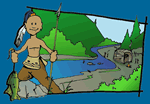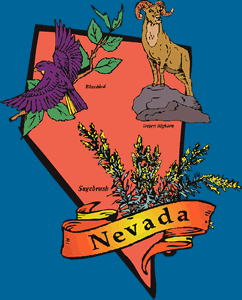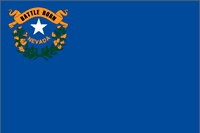 History:
Spanish explorers were probably the first white men to come to the Nevada region. They may have entered the southern portion of the area during the 1770s while journeying from New Mexico to California. But the Spanish did not establish any settlements in Nevada.
More than 50 years later, American trappers and traders came to the area to explore. In 1827, Jebediah Smith led a group of trappers across southern Nevada into California, then back across the Great Basin. A year later, a group of trappers from the Hudson Bay Company, led by Peter Ogden, explored the Humboldt River Valley in the northeastern portion of the region.
The Old Spanish Trail, which connected Sante Fe, New Mexico with Los Angeles, was established in 1830 and extended across southern Nevada. Las Vegas soon became a station along the trail. Three years later, a trapper, Joseph Walker, blazed a trail along the Humboldt River that was heavily used by prospectors and settlers who journeyed to California after gold was discovered there in 1848.
Little was known about the Nevada region until Lieutenant John Fremont, led by Kit Carson, explored the Great Basin and Sierra Nevada between 1843 and 1845. Fremont sent detailed accounts of his experiences to the federal government. After the Mexican War ended in 1848, the United States acquired the Nevada region as part of the Treaty of Guadalupe Hidalgo. At that time, Nevada was part of a larger territory that included California, Utah, and portions of 4 other states.
News about the Nevada region reached Mormon leader Brigham Young, who was journeying west in search of a place to settle with his followers. In 1849, Young established the State of Deseret, which included Utah and a large portion of present-day Nevada. Young asked the government to admit his state to the Union. Instead, Congress established Utah Territory in 1850, which included all of Utah and most of what is now the state of Nevada. The southern tip of the region was still part of New Mexico. Young became the territory's first governor.
Initially, non-Mormons were reluctant to settle in the Mormon-dominated territory, but after the discovery of the Comstock Lode, a rich deposit of silver ore near present-day Virginia City, large numbers of fortune hunters came to Carson County. Mining camps grew overnight and expanded into thriving but raucous towns.
In an attempt to bring law and order to these lawless mining towns, Congress established the Nevada Territory 1861. James Nye was appointed governor of the new territory, but before the territorial government could be set up in Carson City, the Civil War began.
Suddenly the mineral wealth of the territory took on added importance. Silver and gold were needed by both the north and the south to pay the costs of the war. Nevadans favored the Union cause, and President Lincoln was in need of another state to support his anti-slavery amendments. Even though the territory had less than the required population to become a state, Lincoln signed the proclamation for statehood in 1864 and Carson City became the capital. Nevadans elected Henry Blasdel, a mining engineer, as the state's first governor.
Nevada gained its present-day boundaries in 1866 when the southern tip of the state was added and eastern land was acquired from Utah. The completion of the trans-continental railroad in 1869 improved communication with and access to the East. But the state remained highly dependent on its deposits of ore. Nevada suffered severely when the Unites States began limiting the amount of silver used in the monetary system. Mines closed as the price of silver fell, many miners left the state to find work elsewhere, and thriving towns became deserted.
New mineral deposits were discovered at the turn of the century. In 1900, silver ore was found at Tonopah and copper ore at Ely, Ruth, and Mountain City. In 1902, gold was discovered at Goldfield. Thousands of miners returned and Nevada's economic recovery began. |









